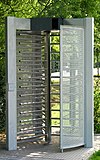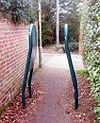Template:Map Features:barrier: Difference between revisions
Jump to navigation
Jump to search
m (to->by motorcycles) |
(added barrier=yes option) |
||
| Line 267: | Line 267: | ||
| {{{turnstile:render| }}} |
| {{{turnstile:render| }}} |
||
| {{{turnstile:photo|[[Image:Barrier_drehkreuz.JPG|100px]]}}} |
| {{{turnstile:photo|[[Image:Barrier_drehkreuz.JPG|100px]]}}} |
||
|- |
|||
| [[{{{barrier:key|key:barrier}}} | barrier]] |
|||
| [[{{{yes:value|Tag:barrier=yes}}} | yes]] |
|||
| {{icon|w}} |
|||
| {{{yes:desc|A barrier which nature cannot be determined; typically only used in mapping using aerial imagery}}} |
|||
| {{{yes:render|[[File:Screenshot from 2014-04-09 19-50-08.png|100px]]}}} |
|||
| {{{yes:photo|[[File:Bing_imagery_showing_buildings_and_barrier.png|100px]]}}} |
|||
|- |
|- |
||
| [[{{{Proposed_features:key|key:barrier}}} | barrier]] |
| [[{{{Proposed_features:key|key:barrier}}} | barrier]] |
||
Revision as of 23:54, 9 April 2014
This documentation is transcluded from Template:Map Features:barrier/doc. (Edit | history)
Note to editors: Please don't categorize this template by editing it directly. Instead, place the category in its documentation page, in its "includeonly" section.
Note to editors: Please don't categorize this template by editing it directly. Instead, place the category in its documentation page, in its "includeonly" section.
Usage
All parameters are optional. By default, text is in English. English writers shall write their comments in the template itself (avoiding double edition). Other languages are translated in template arguments, not in the template itself.
== section header == |name= (section header line) |description= (displayed before the table; optional) == One key/value row == |barrier:key= |gate:value= |gate:desc= |gate:render= |gate:photo=
Template for copy/paste...
<noinclude>{{languages}}</noinclude>
{{Map_Features:barrier
|name=
|description=
|head:key=
|head:value=
|head:element=
|head:desc=
|head:render=
|head:photo=
|head:linear_barrier=
|ditch:desc=
|fence:desc=
|hedge:desc=
|wall:desc=
|head:linear_barrier_sides=
|city_wall:desc=
|retaining_wall:desc=
|head:node_barrier=
|block:desc=
|bollard:desc=
|cattle_grid:desc=
|cycle_barrier:desc=
|motorcycle_barrier:desc=
|toll_booth:desc=
|head:access_node=
|border_control
|chain:desc=
|entrance:desc=
|gate:desc=
|horse_stile:desc=
|kissing_gate:desc=
|lift_gate:desc=
|sally_port:desc=
|stile:desc=
|turnstile:desc=
}}
Barrier
Used to describe barriers and obstacles to travel. See Barriers for more details on usage.
| Key | Value | Element | Comment | Rendering | Photo | |
|---|---|---|---|---|---|---|
| Linear barriers | ||||||
| barrier | city_wall | A fortification used to defend a city or settlement from potential aggressors. From ancient to modern times, they are used to enclose settlements.
|
File:City wall avila.png | |||
| barrier | ditch | A trench, ditch or ravine, usually with a stream at the bottom, that is not easily crossed, especially if not on foot. Can be used in combination with waterway=stream or waterway=drain. |
||||
| barrier | fence | A structure supported by posts driven into the ground and designed to prevent movement across a boundary. It is distinguished from a wall by the lightness of its construction. Use fence_type=* to add details. | 
|

| ||
| barrier | guard_rail | A guard_rail, also called a crash barrier. Right side is inner, left side is outer. | 
| |||
| barrier | hedge | is a line of closely spaced shrubs and bushes, planted and trained in such a way as to form a barrier or to mark the boundary of an area. | 
| |||
| barrier | kerb | A (for example footway) kerb is a barrier for vehicles and wheelchair drivers. The height of the kerb is important and with this information, the usage by different groups can be determined. The height of the kerb is tagged additionally as height=*, if available. Right side is bottom, left side is top. | 
| |||
| barrier | retaining_wall | Retaining walls serve to retain the lateral pressure of soil. Right side is bottom, left side is top. | 
| |||
| barrier | wall | a freestanding solid structure designed to restrict or prevent movement across a boundary. Usually made from solid brick, concrete or stone and almost always built so that it is opaque to vision. | 
|

| ||
| Access control on highways | ||||||
| barrier | block | A large, solid, immobile block that can be moved only with heavy machinery or great effort. Typically big solid things made of concrete for stopping larger vehicles. Sometimes natural boulders are used for the same purpose. |
File:Barrier roadblock.jpg | |||
| barrier | bollard | solid (usually concrete or metal) pillar or pillars in the middle of the road to prevent passage by some traffic. | File:Bollard in residential area.jpg | |||
| barrier | border_control | This is a control point at an international border between two countries. Passports or other forms of ID will be checked. | 
| |||
| barrier | bump_gate | See wikipedia:Bump gate | [1] [2] [3] | |||
| barrier | bus_trap | See wikipedia:Bus trap | 
| |||
| barrier | cattle_grid | Bars in the road surface that allow wheeled vehicles but not animals to cross. Sometimes known as a Texas Gate, even outside of Texas |
||||
| barrier | chain | A chain used to prevent motorised vehicles. | 
| |||
| barrier | cycle_barrier | Barriers to bicycle traffic, most typically a pair of staggered steel bars perpendicular to the way itself whose gaps allow pedestrians to pass. | File:Unknown barrier.jpg | |||
| barrier | debris | A road is blocked by debris with or without ground. This might be for short or long time. Often used as first step in blocking an abandoned road. The photo does not display the road after the debris because it was a slope road and the photo was taken on the top. | 
| |||
| barrier | entrance | A gap in a linear barrier with nothing that limits passing through. access=yes is understood. The limitations are the same of the way that crosses it, if there is such. |

| |||
| barrier | full-height_turnstile | A full-height turnstile, also called HEET-turnstile (High Entrance/Exit Turnstile), like the ones to access security areas. Note the mix of hyphen and underscore. | 
| |||
| barrier | gate | An entrance that can be opened or closed to get through the barrier. Combine with access=* where appropriate. |

| |||
| barrier | horse_stile | A horse stile allows pedestrians and horses to cross a gap through a fence, but prevents or makes it very difficult for motorcycles and live stock to cross. | File:Horse stile.jpg | |||
| barrier | jersey_barrier | A jersey barrier consists of heavy prefabricated blocks to create a barrier. Use material=plastic or material=concrete to express the used material. | 
| |||
| barrier | kent_carriage_gap | A Kent carriage gap is used by local authorities in the UK to prevent motorised vehicles from accessing public rights of way whilst allowing most horse drawn carriages to pass. These are now becoming common on byways in the UK |
[4] | |||
| barrier | kissing_gate | A gate which allows people to cross, but not livestock. | 
| |||
| barrier | lift_gate | A lift gate (boom barrier) is a bar, or pole pivoted in such a way as to allow the boom to block vehicular access through a controlled point. Combine with access=* where appropriate. |
File:Lift gate.jpg | |||
| barrier | log | Use this when the passage is closed by lumber (trunk of a tree). This kind of barrier is often useful to sit on. This barrier is a penalty to cyclists but can be crossed by lifting the bike over. | 
| |||
| barrier | motorcycle_barrier | Barriers along paths that prevent access by motorcycles. | 
| |||
| barrier | rope | A flexible barrier made of fibres, twisted or braided together to improve strength. As a barrier it is often more symbolic than actually physically preventing pedestrians from accessing. | ||||
| barrier | sally_port | A sally port is used to pass through thick or city walls, and is a type of covered gate with two doors. | 
| |||
| barrier | spikes | Spikes on the ground that prevent unauthorized access. Can also be removeable e.g. after payment in a garage. | 
| |||
| barrier | stile | A stile allows pedestrians to cross a wall or fence, but never actually "opens" the barrier (unlike a gate, a stile has few or no moving parts). |

| |||
| barrier | sump_buster | A sump buster is a concrete slab or steel structure that prevents passing of two-tracked vehicles with less than a minimum track and ground clearance. (Typically stops normal cars.) | 
| |||
| barrier | swing_gate | Similar to a lift gate but rotates sidewards to open. It is usually made out of metal bars (wood or other material possible) and is intended to prevent cars from access but can usually be crossed by pedestrians and cyclists. | 
| |||
| barrier | toll_booth | A road usage toll or fee is collected here. | File:Toll booth.jpg | |||
| barrier | turnstile | A turnstile (also called baffle gate) is used to allow one person at a time to pass. Use this for small turnstiles like the ones in supermarkets or some subways. | File:Barrier drehkreuz.JPG | |||
| barrier | yes | A barrier which nature cannot be determined; typically only used in mapping using aerial imagery | 
|

| ||
| barrier | user defined | All commonly used values according to Taginfo | ||||
This table is a wiki template with a default description in English. Editable here.

